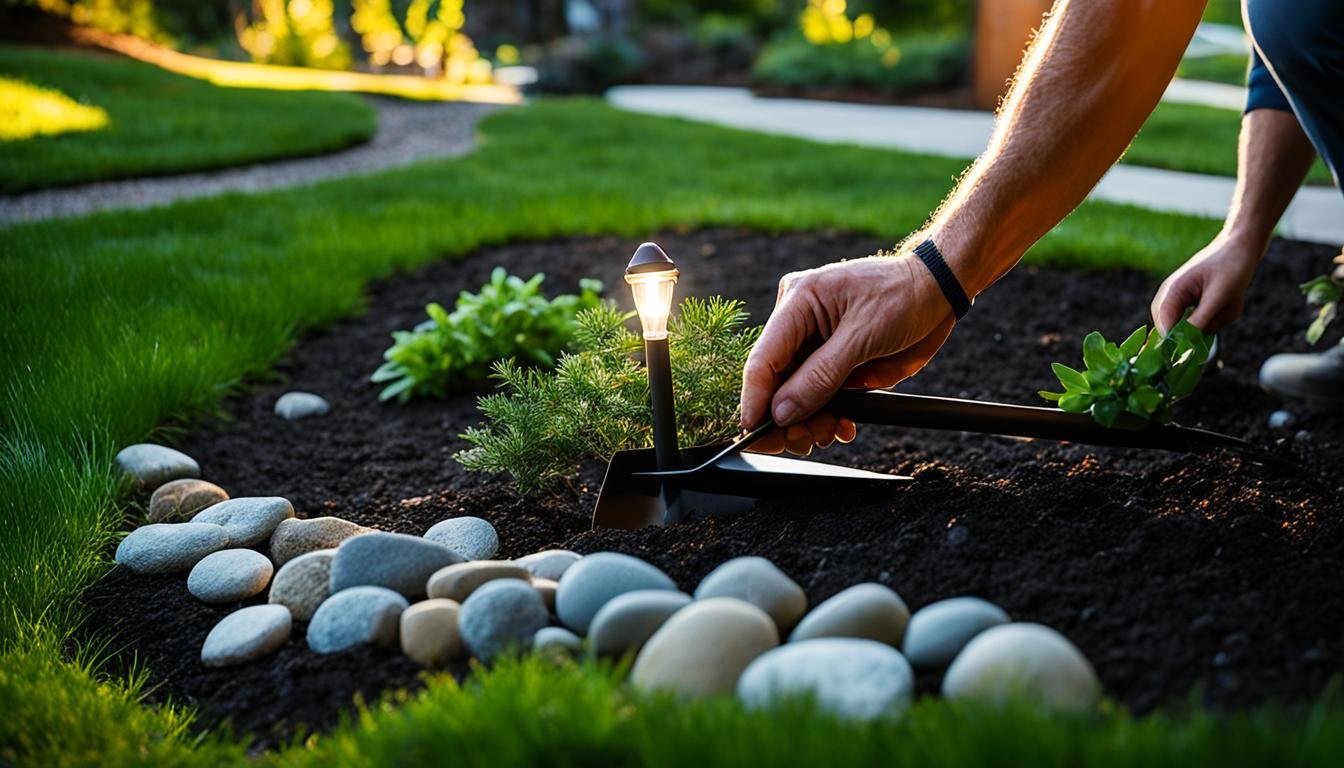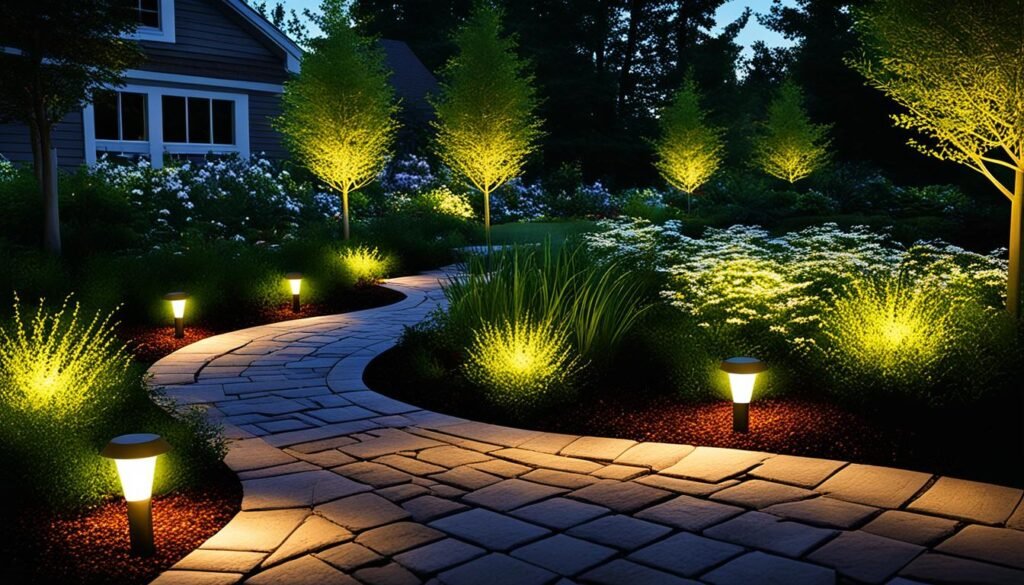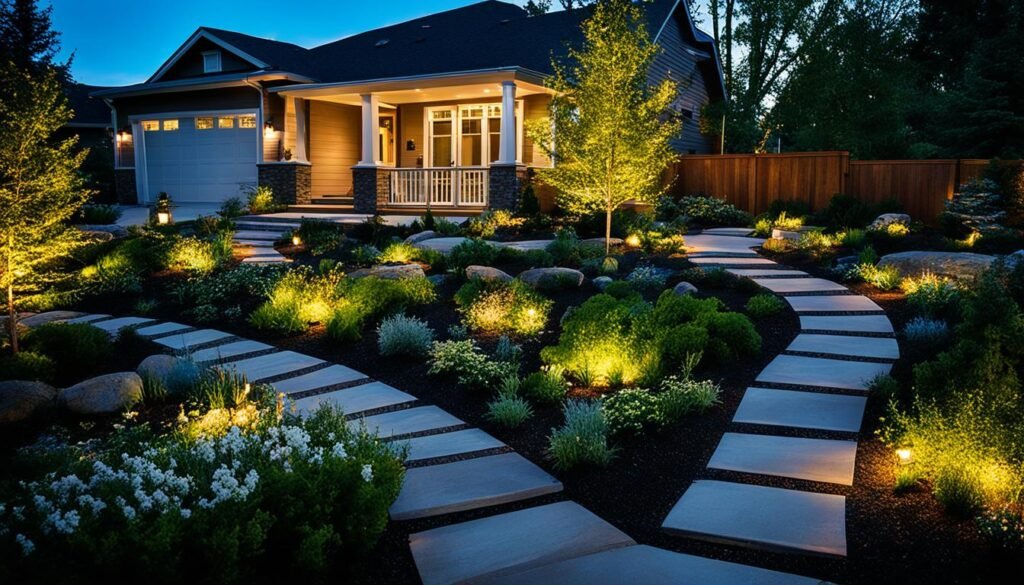
Did you know installing outdoor lighting can cost between $450 and $600? It’s a big step in making your home look better and work better. Our guide will show you how to light up your pathways, highlight your home’s best features, or create a warm glow outside.
We’ll talk about the different kinds of lights you can use, like solar, low voltage, and line voltage. You’ll see the steps to follow for each type, from getting your space ready to setting up the lights and wires. With our advice, you can make your outdoor area look stunning and safe at night.
Key Takeaways
- Landscape lighting can make your outdoor space look better and work better.
- There are three main types of landscape lighting: solar, low voltage, and line voltage, each with their own installation needs.
- Low voltage lighting is easier and safer to put in than line voltage systems.
- Planning is key, including figuring out where to put lights and hiding wires.
- For complex line voltage setups, you might need to talk to a professional electrician to follow local building codes.
Types of Landscape Lighting
When thinking about lighting for your outdoor space, you have many options. You can choose from solar-powered lights, low-voltage, or line-voltage systems. Each type has its own benefits and setup needs. Let’s look at the main types of landscape lighting and what makes them special:
Solar Landscape Lights
Solar lights are a great choice for outdoor lighting. They use a solar panel to charge during the day, so you don’t need any wiring. They’re easy to put in because they don’t need complicated electrical work. But, they need at least six to eight hours of sunlight a day to work well.
Low Voltage Landscape Lights
Low-voltage lights run on 12 volts, which is safer than the usual 120 volts. They use a transformer to reduce the voltage, making them efficient and easy to set up. These lights plug into a GFCI outlet, which is simple and safe.
Line Voltage Landscape Lights
Line-voltage lights work at the same 120 volts as your home’s appliances. They’re wired directly into your home’s electrical system. This means you need an electrician for the complex setup.
When picking the right lighting for your yard, think about energy use, how easy it is to install, and the electrical skills needed. Knowing the differences between solar, low-voltage, and line-voltage lights helps you choose the best for your space.

“Proper placement and installation of landscape lighting can significantly enhance the aesthetic appeal and functionality of your outdoor living spaces.”
landscape lighting how to install
Getting your landscape ready for professional lighting is key to improving your outdoor areas. A well-thought-out plan ensures your lights look great and save energy. Let’s explore the steps to start your landscape lighting project.
Prepare for Installation
First, plan your lighting layout carefully. Read the manufacturer’s guide for the right spacing and placement of lights. Also, mark any underground lines to avoid damage during setup.
Position Fixtures and Wiring
Place your light fixtures about 8-10 feet apart. Run the electrical cable along the fixtures, leaving slack for connections. If you hit a fence or shrub, go under or around it to keep your layout.
Bury the Wire
Use a shovel or trencher to make a 6-inch deep trench for the cable. Lay the cable in the trench, leaving ends exposed near each fixture. Cover the trench with soil, making sure the cable ends are visible. Then, fold back the sod where each fixture will go.
Connect Fixtures to Main Wire Runs
To connect lights to the main cable, use twist-on connectors or clamping junctions. Strip the cable end, twist the wires together, and secure with a connector. Or, use a clamping junction for easy connections. For many fixtures, consider a buried hub for simpler connections.
With careful planning and execution, you’re on your way to a great landscape lighting system. This will boost your outdoor spaces’ beauty and functionality.
Installing Low Voltage Landscape Lighting
Low voltage landscape lighting can make your outdoor space inviting and beautiful. These systems use a transformer to lower the power from 120 volts to a safer 12 volts. This makes them perfect for lighting your yard.
Start by placing the transformer near an outdoor GFCI outlet. This will be the power source for your lights. Then, connect the main cables to the transformer, making sure they’re secure and won’t get wet.
- Put together and place the light fixtures as the maker says, making sure they’re waterproof.
- Lay the cable in a shallow trench, leaving extra wire at each light spot for easy moves later.
- Set the transformer’s timer or sensor to turn the lights on and off automatically, lighting up your yard at dusk and off at dawn.
Low voltage lights are great because they use less energy. LED bulbs in these systems cut down your electric bill a lot compared to old bulbs. Plus, the lower voltage keeps your lights safe, perfect for families with kids or pets.
Think about wire size, voltage drop, and transformer power when planning your lights. With the right setup, you’ll have a beautiful, useful, and energy-saving outdoor lighting system. This will make your yard look great for many years.

| Feature | Advantage |
|---|---|
| Energy Efficiency | LED bulbs in low voltage systems use less power, cutting your electric bill. |
| Safety | With 12V voltage, these lights are safer, great for homes with kids or pets. |
| Flexibility | These systems are easy to add to or change, fitting your yard’s needs over time. |
“A well-designed low voltage landscape lighting system can transform your outdoor space, enhancing the beauty and functionality of your property while also providing energy-efficient and safe illumination.”
Follow these steps and think about important factors for a great low voltage lighting setup. You’ll get a beautiful and efficient outdoor lighting that makes your property look amazing.
Conclusion
Installing landscape lighting can make your outdoor spaces look better and safer. By planning well, picking the right lights, and following a step-by-step guide, you can make a beautiful lighting system. This will make you happy for many years.
The landscape lighting installation tips and DIY landscape lighting guide in this article give you a clear path to your outdoor lighting goals. You’ll learn about different lighting types and how to install them. Now, you can turn your yard into a place that looks great and is safe.
If you run into problems with landscape lighting installation, don’t worry. Contact the experts at Local Landscaping Pros – Murrieta for help. They have lots of experience and care about making customers happy. They’ll make sure your project goes well and meets your expectations.
FAQ
What are the different types of landscape lighting?
How do I plan the layout for my landscape lighting?
How do I install low voltage landscape lighting?
Can I install line voltage landscape lighting myself?
Where can I get help with my landscape lighting installation?
Source Links
- https://www.homedepot.com/c/ah/how-to-install-landscape-lighting/9ba683603be9fa5395fab90d9f6978e
- https://www.thisoldhouse.com/lighting/21016621/how-to-put-in-landscape-lighting
- https://justagirlandherblog.com/install-low-voltage-landscape-lighting/
- https://www.lowes.com/n/how-to/install-landscape-lighting
- https://www.familyhandyman.com/project/lowvoltage-outdoor-lighting/
- https://www.kichler.com/tips-guides/landscape-lighting-guide/getting-started-landscape
- https://simply2moms.com/how-to-easily-install-landscape-lighting-with-no-tools/
- https://www.wikihow.com/Install-Low-Voltage-Lighting
- https://www.superbrightleds.com/blog/planning-for-an-led-landscape-lighting-installation.html
- https://www.angi.com/articles/how-to-install-outdoor-lighting.htm
- https://dcselectric.com/how-to-install-landscape-lighting-and-boost-home-value/
- https://www.thriftydecorchick.com/2015/05/diy-landscaping-lighting-tutorial.html
- https://www.llguys.com/blog/5-ways-landscape-lighting-installations-elevate-your-home






No comment yet, add your voice below!